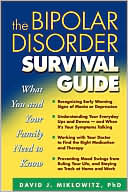Bipolar Disorder Survival Guide: What You and Your Family Need to Know
Search in google:
Thanks to sharper diagnosis and better medicine, the future is far brighter for people with bipolar disorder than was thought possible in past generations. But those struggling with the frantic highs and crushing lows of this illness still have many hurdles to surmount at home, at work, and in daily life. This comprehensive guide offers straight talk that can help people with bipolar disorder take charge of their illness and reclaim their lives. It is filled with practical self-assessment and self-management strategies from a compassionate professional who knows what works. The book helps individuals and family members come to terms with the diagnosis; recognize early warning signs of manic or depressive episodes; cope with triggers for mood swings; manage medication problems and family and work issues; and learn to collaborate effectively with doctors and therapists. Above all, it supplies proven tools to help readers reach toward achieving balance--without sacrificing their right to a rich and varied emotional life. Doody Review Services Reviewer:Diana Marta, BSN, RN(Rush University Medical Center)Description:This is a layman's guide to bipolar disorder. Designed as a supplement to medication, this book targets patients and their families in an effort to enhance treatment with self-management techniques.Purpose:In addition to medication and therapy, the author proposes that self-management is an important tool that can be used by the patient and the family to help recognize the symptoms and help prevent more severe episodes. Any attempt to involve the patient and family in care is a worthy one. This book accomplishes its objectives with this easy-to-read manual.Audience:This book is designed primarily for patients and family, although anyone in a support or professional role working with affected clients could benefit from this information. The author has done extensive research for the NIMH, including showing that self-management techniques, when combined with medication, improve outcome.Features:After covering medication and diagnosis of bipolar disorder, the author breaks down self-management into four steps: 1) accepting the diagnosis, 2) becoming an expert on one's moods, 3) educating family and friends, and 4) enlisting support. Recognizing how misunderstood the illness is and how much more resistance to treatment occurs, this book attempts to address both of these issues. I liked the proposed contracts and forms suggested as extra tools and the book's organization.Assessment:As a layman's tool, I think this is an excellent resource. It breaks down bipolar illness into manageable components, poses questions about each, and then presents practical and realistic solutions that can be used by the patient and family to enhance treatment. My only concern is whether it will be perceived as a replacement for medication rather than as a supplement to it. That certainly is only a minor concern. For the most part, I think this is an excellent addition to a patient or family's reference library.
PrefacePt. IThe Diagnosis and Course of Bipolar Disorder1Why Do I Need This Book?32What Bipolar Disorder Looks Like - to You, to the Doctors, and to Everyone Else133Into the Doctor's Court: What to Expect from the Diagnostic Process304Is It an Illness or Is It Me?: Tips on Coping with the Diagnosis54Pt. IICauses and Treatments5Where Does Bipolar Disorder Come From?: Genetics, Biology, and Stress736What Can Medication and Psychotherapy Do for Me?987Coming to Terms with Your Medication129Pt. IIISelf-Management8How Can I Manage My Disorder?: Practical Ways to Maintain Wellness1519What Can I Do It I Think I'm Getting Manic?18310What Can I Do If I Think I'm Getting Depressed?21411Dealing with Suicidal Thoughts and Feelings23812Coping Effectively in the Family and Work Settings254Resources for People with Bipolar Disorder291References297Index311About the Author322








